What is CO2 compensation? Let's understand what it is
The compensation of CO2 emissions (or Carbon offsetting) is an activity that makes it possible to balance the impact on Global Warming, funding environmental projects able to avoid, reduce or remove greenhouse gas emissions into the atmosphere.
For example, through the conservation of forests or the installation of renewable energy production plants in particularly disadvantaged regions, where energy is still generated using almost exclusively fossil fuels.
What are CO2 compensation projects and what standards must they comply with
The CO2 compensation projects aim to reduce or absorb greenhouse gas emissions through specific environmental actions, such as reforestation, forest conservation or the development of renewable energy.
Emission compensation projects can be divided into 2 types:
- nature based projects, which protect, manage and restore natural ecosystems, simultaneously providing human well-being and benefits for biodiversity;
- technology-based projects, which, through innovative technologies, avoid the emission or carry out the sequestration of carbon dioxide.
To be effective and reliable, and to be able to generate certified carbon credits, these projects must comply with strict international standards, which guarantee the quality of offset emissions and the transparency of the process.
There are international entities that deal with verify That a project respects certain requirements. This makes it possible to ensure that the offsetting obtained from the carbon credits generated through these projects both transparent And say quality.
The most widely used global standard is the Verra Verified Carbon Standard (VCS). This establishes the rules and requirements that all compensation projects they must follow to be certified.
The necessary requirements for a certified project
In order to pass the verification of the main international certification bodies (Verra or Gold Standard) the project must comply with binding requirements. Let's see what they are below.
- Measurability: emission reductions must be able to be measured according to recognized instruments.
- Permanence: it must be demonstrated that the CO2 Once removed, it is not returned to the atmosphere at a later date. For example, if a forestry project is located in a region with a high prevalence of fires, the forest could be affected and release the greenhouse gases that had been seized into the atmosphere.
- Additionality: the project must be developed with the sole purpose of capturing or avoiding the emission of CO2. For example, a fruit tree was probably planted to produce fruit, and the CO2 What catch is not really additional compared to the case in which we had not invested in compensation.
- Transparency: information related to projects and carbon credits must be clear and transparent.
- Conservativity: the capacity of projects to reduce GHG emissions must not be overestimated, and only CO
- 2
- Positive co-benefits: some projects go beyond reducing emissions, implementing activities that benefit local communities and biodiversity. For example: if a project protects a forest, but compromises the livelihood of local communities by cutting off an essential source of income, it is a poorly conceived project and not in line with the SDGs.
- Third-party audits: all emission reductions must be verified by an accredited third party.
How does CO2 compensation work in practice: what are carbon credits
At this point we can clearly understand what carbon credits, or Carbon Credit. They can be defined as an instrument that certifies the capture or non-emission of CO2 through certified environmental projects.
In particular, each carbon credit corresponds to one ton of CO2 tantamount compensated.
1 carbon credit = 1 ton of CO2 eq
How does the carbon credit market work
In voluntary market for carbon credits (Voluntary Carbon Market), organizations can buy carbon credits, mitigating spontaneously its impact on climate change.
Companies, in this case, can purchase carbon credits from two parties:
- directly from the project developers;
- by accredited bodies for resale on the secondary market, such as Up2You.
In addition to Voluntary Carbon Market, there is the compliance market, like the Emission Trading System (EU ETS), which consists of a Compulsory market which regulates companies in certain sectors, setting a Maximum ceiling to the emissions produced and the number of quotas with which to tax the excess emissions produced annually (1 ton of CO₂ eq. = 1 share).
In compliance market, companies that are unable to cover the emissions produced with the allotted quotas They must buy other shares, so as to balance the excess issue shares.
If you are interested in learning more about the topic, we have created a white paper with all the details related to the carbon credit market.
What does an effective decarbonization strategy consist of: reducing and offsetting emissions
Very often, companies make the mistake of seeing the offsetting Like a shortcut Towards the goal Net Zero. On the other hand, it seems easy: I emit a certain amount of CO2 eq, I make up for it by buying carbon credits.
In reality this is not really the case: the compensation of CO2 should be seen as a complementary solution to the reduction of emissions.
Before compensating, companies they must reduce their emissions to a minimum through sustainable practices, such as the adoption of renewable energy or the optimization of production processes.
According to the very definition of Net Zero, in a correct decarbonization path, the company must be on a trajectory of reducing emissions aligned with Paris objectives (i.e. the containment of the increase in the global average temperature below the 2°C threshold).
Only after implementing a reduction plan is it possible to offset non-reducible emissions through certificate projects (preferably Carbon removal).






























